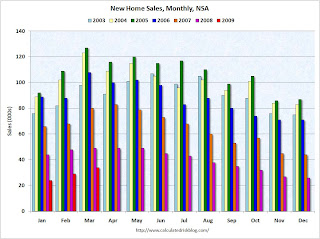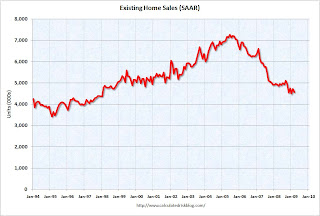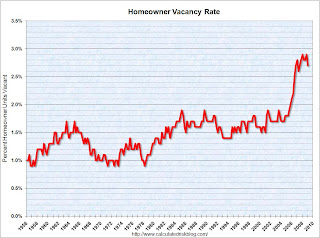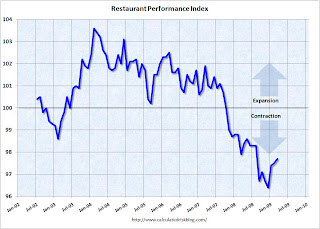April Economic Summary in Graphs
by CalculatedRisk on 4/30/2009 04:00:00 PM
Here is a collection of real estate and economic graphs for data released in April ...
 New Home Sales in March
New Home Sales in MarchThe first graph shows monthly new home sales (NSA - Not Seasonally Adjusted).
Note the Red columns for 2009. This is the lowest sales for March since the Census Bureau started tracking sales in 1963. (NSA, 34 thousand new homes were sold in March 2009; the previous low was 36 thousand in March 1982).
From: New Home Sales: 356 Thousand SAAR in March
 Housing Starts in March
Housing Starts in MarchTotal housing starts were at 510 thousand (SAAR) in March, just above the revised record low of 488 thousand in January (the lowest level since the Census Bureau began tracking housing starts in 1959).
Single-family starts were at 358 thousand in March; just above the revised record low in January (356 thousand).
From: Housing Starts: Near Record Low
 Construction Spending in February
Construction Spending in FebruaryThis graph shows private residential and nonresidential construction spending since 1993. Note: nominal dollars, not inflation adjusted.
"Residential construction was at a seasonally adjusted annual rate of $275.1 billion in February, 4.3 percent below the revised January estimate of $287.4 billion. Nonresidential construction was at a seasonally adjusted annual rate of $390.7 billion in February, 0.3 percent above the revised January estimate of $389.5 billion."
From: Construction Spending Declines in February
 March Employment Report
March Employment ReportThis graph shows the unemployment rate and the year over year change in employment vs. recessions.
Nonfarm payrolls decreased by 663,000 in March. January job losses were revised to
741,000. The economy has lost almost 3.3 million jobs over the last 5 months, and over 5 million jobs during the 15 consecutive months of job losses.
The unemployment rate rose to 8.5 percent; the highest level since 1983.
From: Employment Report: 663K Jobs Lost, 8.5% Unemployment Rate
 March Retail Sales
March Retail SalesThis graph shows the year-over-year change in nominal and real retail sales since 1993.
On a monthly basis, retail sales decreased 1.1% from February to March (seasonally adjusted), but sales are off 10.7% from March 2008 (retail and food services decreased 9.4%). Automobile and parts sales declined 2.3% in March (compared to February), but excluding autos, all other sales declined -0.9%.
From: Retail Sales Decline in March
 LA Port Traffic in March
LA Port Traffic in MarchThis graph shows the loaded inbound and outbound traffic at the port of Los Angeles in TEUs (TEUs: 20-foot equivalent units or 20-foot-long cargo container). Although containers tell us nothing about value, container traffic does give us an idea of the volume of goods being exported and imported.
Inbound traffic was 6% below last March and 35% above last month.
Outbound traffic was 9.8% below March 2008, and 25% above February.
From: LA Port Import Traffic Rebounds
 U.S. Imports and Exports Through February
U.S. Imports and Exports Through FebruaryThe first graph shows the monthly U.S. exports and imports in dollars through February 2009. The recent rapid decline in foreign trade continued in February. Note that a large portion of the recent decline in imports was related to the fall in oil prices, however the decline in February was mostly non-oil related.
From: U.S. Trade Deficit: Lowest Since 1999
 March Capacity Utilization
March Capacity UtilizationThis is some serious cliff diving. Also - since capacity utilization is at a record low (the series starts in 1967), there is little reason for investment in new production facitilies.
The Federal Reserve reported that "industrial production fell 1.5 percent in March after a similar decrease in February. For the first quarter as a whole, output dropped at an annual rate of 20.0 percent, the largest quarterly decrease of the current contraction. At 97.4 percent of its 2002 average, output in March fell to its lowest level since December 1998 and was nearly 13 percent below its year-earlier level.
From: Industrial Production Declines Sharply in March
 NAHB Builder Confidence Index in April
NAHB Builder Confidence Index in AprilThis graph shows the builder confidence index from the National Association of Home Builders (NAHB).
The housing market index (HMI) increased to 14 in April from 9 in March. The record low was 8 set in January.
The increase in April follows five consecutive months at either 8 or 9.
From: NAHB: Builder Confidence Increases in April
 Architecture Billings Index for March
Architecture Billings Index for March"After a series of historic lows, the Architecture Billings Index (ABI) was up more than eight points in March. As a leading economic indicator of construction activity, the ABI reflects the approximate nine to twelve month lag time between architecture billings and construction spending. The American Institute of Architects (AIA) reported the March ABI rating was 43.7, up from the 35.3 mark in February. This was the first time since September 2008 that the index was above 40..."
From: Architecture Billings Index Increases in March
 Vehicle Miles driven in February
Vehicle Miles driven in FebruaryThis graph shows the annual change in the rolling 12 month average of U.S. vehicles miles driven. Note: the rolling 12 month average is used to remove noise and seasonality.
By this measure, vehicle miles driven are off 3.6% Year-over-year (YoY); the decline in miles driven is worse than during the early '70s and 1979-1980 oil crisis.
From: DOT: U.S. Vehicle Miles Off 0.9% in February
 Existing Home Sales in March
Existing Home Sales in MarchThis graph shows existing home sales, on a Seasonally Adjusted Annual Rate (SAAR) basis since 1993.
Sales in March 2009 (4.57 million SAAR) were 3.0% lower than last month, and were 7.1% lower than March 2008 (4.92 million SAAR).
It's important to note that about 45% of these sales were foreclosure resales or short sales. Although these are real transactions, this means activity (ex-distressed sales) is under 3 million units SAAR.
From: Existing Home Sales Decline in March
 Existing Home Inventory March
Existing Home Inventory MarchThis graph shows nationwide inventory for existing homes. According to the NAR, inventory decreased to 3.74 million in March. The all time record was 4.57 million homes for sale in July 2008. This is not seasonally adjusted.
Typically inventory increases slightly in March, and then really increases over the next few months of the year until peaking in the summer. This decrease in inventory was small, and the next few months will be key for inventory.
Also, most REOs (bank owned properties) are included in the inventory because they are listed - but not all. Recently there have been stories about a substantial number of unlisted REOs - this is possible, but not confirmed.
From: Existing Home Sales Decline in March
 Case Shiller House Prices for February
Case Shiller House Prices for FebruaryThis graph shows the nominal Composite 10 and Composite 20 indices (the Composite 20 was started in January 2000).
The Composite 10 index is off 31.6% from the peak, and off 2.1% in February.
The Composite 20 index is off 30.7% from the peak, and off 2.2% in February.
From: Case-Shiller: House Prices Fall Sharply in February
 Homeownership Rate for Q1
Homeownership Rate for Q1The homeownership rate decreased to 67.3% and is now back to the levels of Q2 2000.
Note: graph starts at 60% to better show the change.
The homeownership rate increased because of demographics and changes in mortgage lending. The increase due to demographics (older population) will probably stick, so I expect the rate to decline to the 66% to 67% range - and not all the way back to 64% to 65%.
From: Q1 2009: Homeownership Rate at 2000 Levels
 Homeownership Vacancy Rate Q1
Homeownership Vacancy Rate Q1The homeowner vacancy rate was 2.7% in Q1 2009.
A normal rate for recent years appears to be about 1.7%. There is some noise in the series, quarter to quarter, so perhaps the vacancy rate has stabilized in the 2.7% to 2.9% range.
This leaves the homeowner vacancy rate about 1.0% above normal ...
From: Q1 2009: Homeownership Rate at 2000 Levels
 Rental Vacancy Rate for Q1
Rental Vacancy Rate for Q1The rental vacancy rate was steady at 10.1% in Q1 2009.
It's hard to define a "normal" rental vacancy rate based on the historical series, but we can probably expect the rate to trend back towards 8%.
From: Q1 2009: Homeownership Rate at 2000 Levels
 Unemployment Claims
Unemployment ClaimsThis graph shows weekly claims and continued claims since 1971.
The four week moving average is at 637,250, off 21,500 from the peak 3 weeks ago.
Continued claims are now at 6.27 million - the all time record.
From: Unemployment Claims: Record Continued Claims
 Restaurant Performance Index for March
Restaurant Performance Index for March"The outlook for the restaurant industry improved in March, as the National Restaurant Association’s comprehensive index of restaurant activity rose for the third consecutive month. The Association’s Restaurant Performance Index (RPI) – a monthly composite index that tracks the health of and outlook for the U.S. restaurant industry – stood at 97.7 in March, up 0.2 percent from February and 1.3 percent during the last three months."
From: Restaurant Performance Index Increases Slightly
 New Home Sales: March
New Home Sales: MarchThis graph shows New Home Sales vs. recessions for the last 45 years. New Home sales have fallen off a cliff.
Sales of new one-family houses in March 2009 were at a seasonally adjusted annual rate of 356,000, according to estimates released jointly today by the U.S. Census Bureau and the Department of Housing and Urban Development.From: New Home Sales: 356 Thousand SAAR in March
This is 0.6 percent (±19.0%)* below the revised February rate of 358,000 and is 30.6 percent (±10.7%) below the March 2008 estimate of 513,000.
 New Home Months of Supply: March
New Home Months of Supply: MarchThere were 10.7 months of supply in March - significantly below the all time record of 12.5 months of supply set in January.
"The seasonally adjusted estimate of new houses for sale at the end of March was 311,000. This represents a supply of 10.7 months at the current sales rate."
From: New Home Sales: 356 Thousand SAAR in March







































No comments:
Post a Comment